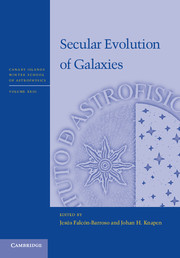Book contents
- Frontmatter
- Contents
- List of contributors
- Participants
- Preface
- Acknowledgments
- Secular evolution in disk galaxies
- Galaxy morphology
- Dynamics of secular evolution
- Bars and secular evolution in disk galaxies: Theoretical input
- Stellar populations
- Star formation rate indicators
- The evolving interstellar medium
- Evolution of star formation and gas
- Cosmological evolution of galaxies
- References
Cosmological evolution of galaxies
Published online by Cambridge University Press: 05 September 2013
- Frontmatter
- Contents
- List of contributors
- Participants
- Preface
- Acknowledgments
- Secular evolution in disk galaxies
- Galaxy morphology
- Dynamics of secular evolution
- Bars and secular evolution in disk galaxies: Theoretical input
- Stellar populations
- Star formation rate indicators
- The evolving interstellar medium
- Evolution of star formation and gas
- Cosmological evolution of galaxies
- References
Summary
Abstract
I review the subject of the cosmological evolution of galaxies, including different aspects of growth in disk galaxies, by focussing on the angular momentum problem, mergers, and their by-products. I discuss the alternative to merger-driven growth – cold accretion and related issues. In the follow-up, I review possible feedback mechanisms and their role in galaxy evolution. Special attention is paid to high-redshift galaxies and their properties. In the next step, I discuss a number of processes, gas- and stellar-dynamical, within the central kiloparsec of disk galaxies, and their effect on the larger spatial scales, as well as on the formation and fuelling of the seed black holes in galactic centres at high redshifts.
Introduction: the paradigm of galaxy evolution
The aim of these lectures is to review the main aspects of secular galaxy evolution, i.e., galaxy evolution on cosmological scales. Two issues stand out in this attempt. First, the subject is immense and cannot be covered within the scope of this chapter. And second, one cannot ignore the fact that galaxy evolution is part of the overall evolution in the Universe – from the largest spatial scales ruled by dark matter (DM) to the smallest ones taken over by dissipative baryons that can form stars and grow supermassive black holes (SMBHs). In other words, the process of galaxy formation can be influenced strongly by a huge range of spatial scales.
- Type
- Chapter
- Information
- Secular Evolution of Galaxies , pp. 555 - 638Publisher: Cambridge University PressPrint publication year: 2013
References
- 19
- Cited by

